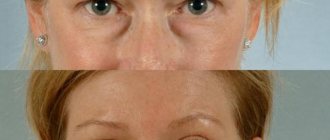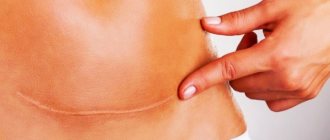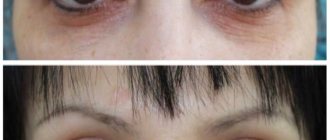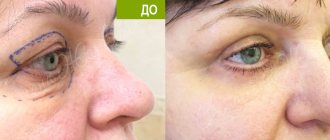As people age, the skin around their eyes undergoes aging.
Wrinkles form around it and it sags. The amount of subcutaneous fat and tissue swelling also increases.
The most gentle surgical intervention to eliminate these defects is considered to be transconjunctival blepharoplasty of the lower eyelids. It is used to make an incision in the conjunctival area. Therefore, after the procedure there are no scars or stitches. As a result, the patient’s swelling completely disappears, the skin becomes tightened, and the doctor also removes excess fatty tissue. Since the procedure is considered minimally invasive, the rehabilitation period is short.
Difference from standard eyelid blepharoplasty
In classical surgery, the incision is made on the outer surfaces of the upper and lower eyelids. This is done using a surgical scalpel. This technique is considered risky for the eyes and the skin around them. Therefore, many doctors advise against performing it, recommending the transconjunctival method.
Also, with the classical method, only general anesthesia is performed, which can cause many complications for the patient’s health. With the transconjunctival method, local anesthesia can be used.
With the classical method, the rehabilitation period is significantly increased, since the skin surfaces, blood vessels and nerves have been damaged.
That is why transconjunctival blepharoplasty is considered the safest and most justified method for facial rejuvenation. The surgeon gains access to the desired area through the mucous membrane and conjunctiva of the eye. There is no incision; instead, a puncture is made. Therefore, there are no stitches left, and the doctor does not damage the vessels and nerves.
Laser blepharoplasty: young eyes should look wrinkle-free!
Contrary to popular myths, it is impossible to eliminate crow's feet using classic blepharoplasty.
For radical eye rejuvenation, we at Platinental combine surgery with light fractional laser eyelid peeling. Carbon dioxide laser allows you to make the skin more elastic after surgery, erase the relief of fine wrinkles and improve its color, especially for those who suffer from dark circles under the eyes.
Resurfacing is performed in the clinic simultaneously with the operation under TIVA anesthesia, so pain is excluded.
Indications for surgery
First of all, surgical intervention is performed for patients who want to eliminate a cosmetic defect in the form of bags under the eyes, severe wrinkles, and sagging skin. The procedure is also indicated for the following conditions and diseases:
- damage to the protective septum of the eye, hernia formation;
- excessive drooping of the skin of the eyelids, which interferes with normal life activities;
- stretching of the skin above and below the eye, as well as in the corner above the eyebrow;
- excessive accumulation of subcutaneous fat, which forms large bags under the eyes.
If bags under the eyes are associated with severe sagging skin, the procedure will be ineffective and will only slightly improve the patient’s condition. With the transconjunctival method, it is possible to completely eliminate the bags only in the presence of excess adipose tissue.
Day of surgery: how lower blepharoplasty works
Corrective blepharoplasty of the lower eyelids is performed under local anesthesia or general anesthesia. The choice is made jointly by the doctor and the patient.
Lower eyelid surgery under general anesthesia
In the ward, after the conversation, the anesthesiologist will give you a sedative injection. After this, you will fall asleep in the operating room. Under anesthesia, the doctor will perform the necessary manipulations. The fat that forms the so-called “hernias” under the eyes is either removed or carefully redistributed. If necessary, the eyelid tissues are tightened and lipofilling is performed. Then a blindfold is applied to the eyes. With her, the patient dozes for another hour in the ward. When you regain your alertness, this cooling bandage will be removed and you can leave the clinic.
Lower eyelid surgery under local anesthesia
If local anesthesia is chosen, then before the operation the doctor will give a couple of pain-relieving injections into the eyelids. After a few minutes, sensitivity will disappear and the patient will not feel any further manipulation. Those who are nervous and afraid may be offered a calming injection before the operation.
Contraindications
The procedure is not recommended for the following conditions and diseases:
- minor age;
- infectious and viral diseases in the acute stage;
- presence of menstrual bleeding in women;
- malignant neoplasms in any tissues and organs;
- hormonal imbalance, pathologies of the endocrine glands;
- any disturbances in the circulatory system;
- increased bleeding time, decreased blood clotting;
- increased intraocular pressure or glaucoma;
- high blood pressure;
- autoimmune disease (rheumatoid arthritis, systemic lupus erythematosus, autoimmune reactions in thyroid diseases);
- dry eye syndrome – insufficient hydration in the absence or reduced secretion of tear fluid;
- congenital or acquired immunodeficiency.
Some of these contraindications are temporary. When their effect is completed, the doctor can give a referral for surgery.
If the patient has a serious illness of the body, blepharoplasty is completely prohibited.
What else does the period depend on?
Recovery time also varies depending on the complexity and volume of operations and, of course, the technique. Rehabilitation after transconjunctival blepharoplasty will take less time than rehabilitation after circular blepharoplasty, because circular correction is more traumatic for tissues.
To speed up the resolution of bruises and swelling, you can apply cold compresses and use ointments that stimulate the reduction of bruising and swelling. It is also advisable to sleep in a semi-sitting position to prevent blood flow to the head. To do this you will need several pillows.
Preparation for transconjunctival blepharoplasty
To carry out the procedure, the patient should undergo all studies and tests so that no side effects or complications arise during the operation or during the rehabilitation period.
Before the procedure, the patient should undergo tests:
- general clinical analysis of blood and urine, blood biochemistry, coagulogram;
- testing for hepatitis and HIV;
- fluorography;
- electrocardiogram.
If there are no contraindications based on these data, the patient is referred to specialist doctors. He must see an ophthalmologist, otolaryngologist, dentist, and neurologist.
Before the procedure itself, the patient should prepare:
- 2 weeks before surgery, it is prohibited to use medications that the doctor has not been warned about;
- any medications that may thin the blood are discontinued;
- you should not visit places with active sun;
- It is prohibited to consume alcohol and nicotine 3 days before the procedure.
You should not wear makeup on the day of surgery. The patient should take a warm shower and thoroughly wash his hair and face. It is also recommended to take sick leave at work, since visiting her is not recommended during the rehabilitation period.
What drugs should I use?
During rehabilitation after laser or classical blepharoplasty, the doctor prescribes medications for external use that stimulate the resorption of bruises and the reduction of swelling. Some ointments or creams may be prescribed to relieve itching and speed up tissue regeneration. It is important to remember that you cannot prescribe medications for yourself, since the wrong prescription can ruin the result of the correction.
In addition to medications, physiotherapy may be indicated - microcurrents, darsonval and others. These treatments also stimulate faster tissue repair in the damaged area. But before you sign up for a particular procedure, you should definitely discuss it with your surgeon.
To speed up tissue healing, special ointments are used.
In rare cases, antibiotics and other antibacterial medications may be prescribed to minimize the risk of infection. Analgesics are also sometimes prescribed if the patient complains of acute pain.
Carrying out the operation
The procedure is carried out quickly, the maximum time is 1 hour. But if there are complications, the time may increase. Before anesthesia is administered, markings are made on the face using a special marker. The doctor will use it to determine which areas need to be tightened and where the amount of fatty tissue needs to be reduced.
Next, the procedure is carried out in several stages:
- Use of anesthetic in required areas of the face.
- The use of epinephrine, which is an analogue of adrenaline. It reduces the risk of bleeding.
- The surgeon makes a miniature puncture in the conjunctival area, which is located behind the eyelash growth area. No further incisions are made.
- Using a special device, the doctor removes excess fat tissue.
- The hole is stitched with suture material, which subsequently dissolves on its own. The surgeon will not need to remove additional suture material. In some cases, the surgeon may refuse to use suture material, then the hole will heal on its own.
- The use of antibacterial, anti-inflammatory agents.
After completion of the procedure, the patient must remain within the walls of the medical institution for several hours. If no complications or side effects appear, he is sent home the same day. This is due to the fact that a small amount of tissue was damaged. The doctor does not need to perform additional manipulations.
The patient is advised to ask for help from close relatives or friends who will pick him up from the medical facility. This is due to the fact that after surgery, visual acuity may decrease for a short period of time. This will also avoid stress on human health immediately after the procedure.
How long does rehabilitation take after blepharoplasty?
The concept of “recovery period” includes everything from the operation itself to complete healing of the tissue. This is not only care or prohibitions, but also therapy, physiotherapy, therapeutic exercises and much more. Unfortunately, despite all the efforts of the doctor and the patient, at first, even with careful adherence to all prescriptions, various unpleasant sensations will cause discomfort:
- pain,
- dry mucous membranes,
- “sand” in the eyes, etc.
It is important to understand that discomfort, as well as some external effects (swelling, hematomas, etc.) are not beyond normal limits and are present after any operation.
Recovery time can take from two weeks to two months. Rehabilitation after blepharoplasty of the upper or lower eyelids is very individual and depends on the characteristics of the individual patient. For example, the age category of the patient is very influential - the older you are, the more difficult and longer the healing takes.
Rehabilitation period
To reduce the possibility of side effects and complications after surgery, it is important for the patient to undergo a proper rehabilitation period. The doctor warns the person in advance about its rules:
- the use of antibacterial, anti-inflammatory drops, which prevent the spread of infection to the area of damage, and also relieve redness and swelling of tissues;
- using moisturizing eye drops to prevent increased dryness of the mucous membrane and damage to the corneal layer;
- prohibition on using cosmetics for 1 week after the procedure;
- prohibition on visiting a sauna, bathhouse, sunbathing in the open sun, swimming in hot water for 2-3 weeks after surgery, this will prevent the possibility of bleeding;
- Wearing sunglasses outdoors to prevent eye irritation from bright sunlight;
- long sleep, no increased eye strain in the form of using a computer, telephone and other electronic devices;
- You can go to work 1 week after the operation, but you must obtain permission from the attending physician;
- significantly reduce physical activity, do not engage in active sports until the doctor’s permission;
- You cannot wear contact lenses for 1 month after surgery.
After 1 week, as well as 30 days after the operation, it is recommended to visit the surgeon for a follow-up examination. If there are no side effects, the doctor will gradually lift the ban on any actions.
Video
Example of transconjunctival blepharoplasty
Cost of transconjunctival blepharoplasty
| Name | Price |
| Surgical correction of the lower eyelids transconjunctivally | 75,000 rub. |
| Primary appointment (examination, consultation) with a plastic surgeon | FOR FREE |
Possible complications
During the procedure, as well as during the rehabilitation period, the following complications may occur in the patient’s body:
- bleeding from the area of tissue damage;
- corneal bruises, if they are minor, the doctor does not prescribe any medical manipulations, they resolve on their own; in case of extensive bruises, injections of drugs into the eyeball can be used;
- internal hemorrhage near the eyeball, resulting in the formation of a hematoma that does not resolve for a long time;
- damage to the tissues of the eyeball during surgery, which are the most dangerous for the condition of the patient’s visual organs;
- severe bleeding that the doctor cannot stop for a long time;
- formation of age spots under the eyes;
- infection with a bacterial infection with the possibility of suppuration, the formation of cysts and abscesses, this is dangerous for the patient, since the bacterial infection can enter the blood through damaged vessels;
- the appearance of chronic dry eyes with damage to the corneal layer, in this case the patient is prescribed moisturizing drops or injections into the eyeball with special preparations for life;
- severe swelling that does not go away for a long time after surgery;
- increased tearfulness, this condition subsequently disappears with tissue healing;
- deformation of the eyelid, due to which it becomes inverted, which causes dry eyes, inflammation and redness of the surface layer;
- excessive tissue scarring;
- photophobia, accompanied by increased lacrimation, redness of the eyes and spasm of the eyelids;
- decreased visual acuity, which most often recovers within 1 month after surgery;
- increased intraocular pressure, which can subsequently form glaucoma.
If the patient chooses a highly qualified surgeon, the risk of complications is significantly reduced. But with health problems, especially in old age, certain risks remain. Therefore, doctors recommend a comprehensive examination of the body before the procedure.
The trust of celebrity patients is one of the best proofs of the “couture” level of skill
Let’s not hide that Platinental surgeons trust their eyes to celebrities and politicians.
We are somehow accustomed to the fact that all stars undergo plastic surgery. But we rarely think that they are not only the most demanding patients. They are also the busiest. Their filming and touring schedule is planned 3-5 years in advance .
Due to lack of time and the nature of the profession, such patients always make 2 strict demands:
- the operation should take place without complications and have the shortest possible recovery period,
- the operation must provide a long-term result and be done as rarely as possible, because forced downtime can easily ruin a career.
And the stars of politics and business present one more thing.
They are not eager to make public the fact of the anti-aging procedures performed. Therefore, the operations that we perform at Platinental provide the most natural result without the effect of an operated face. Everything looks as if the person began to lead a healthy lifestyle and gets enough sleep regularly .
We are pleased to offer all these technologies to you.
Iskornev Andrey, plastic surgeon.
Eyes are the main factor of attractiveness. They determine how sociable you are, what mood you are in, what mood you are in, whether you are flirtatious or strict, analytical or, conversely, prone to adventurism.
The harmony of the eyes, like all facial features, has its own rules, but the degree of “deviation” from the conventional norm can be much greater than with the shape of the lips, nose or chin.
Despite this, there are strict rules:
— The contour of the lower eyelid should touch the lower border of the iris, otherwise the eyes look round, “fishy”, this is how the eyelid of an elderly person looks. That is why lower eyelid blepharoplasty is a special science, and only a few surgeons are concerned about the stability of the eyelid shape after such an operation.
Regular and fisheye
— The outer corner of the eye should be 2-3mm higher than the inner one. This creates the effect of an almond-shaped eyelid, which on a woman’s face emphasizes the artistry and sexuality of nature.
Regular and almond-shaped eyes
- There should be a small roll of muscle under the lower eyelid (pretarsal roll of the lower eyelid). This should definitely be taken into account when planning lower eyelid blepharoplasty. The surgeon must be able to model this roll of muscle to highlight the youthful shape of the eyelid and the natural result of rejuvenation.”
The pretarsal ridge of the lower eyelid on Kate Middleton, Emma Watts and the model from the Christian Dior show certainly speaks of their youth.










